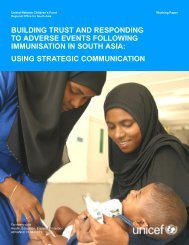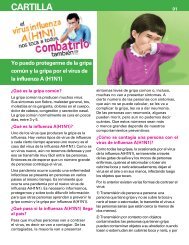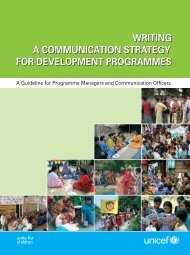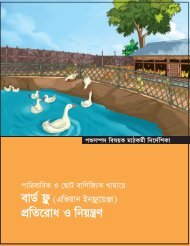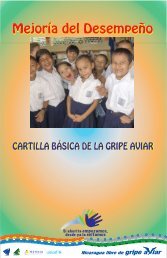FAO-OIE-WHO Joint Technical Consultation on Avian Influenza at ...
FAO-OIE-WHO Joint Technical Consultation on Avian Influenza at ...
FAO-OIE-WHO Joint Technical Consultation on Avian Influenza at ...
- No tags were found...
Create successful ePaper yourself
Turn your PDF publications into a flip-book with our unique Google optimized e-Paper software.
<str<strong>on</strong>g>FAO</str<strong>on</strong>g>-<str<strong>on</strong>g>OIE</str<strong>on</strong>g>-<str<strong>on</strong>g>WHO</str<strong>on</strong>g> <str<strong>on</strong>g>Joint</str<strong>on</strong>g> <str<strong>on</strong>g>Technical</str<strong>on</strong>g> <str<strong>on</strong>g>C<strong>on</strong>sult<strong>at</strong>i<strong>on</strong></str<strong>on</strong>g> <strong>on</strong> <strong>Avian</strong> <strong>Influenza</strong> <strong>at</strong> the Human-Animal Interface4. Understanding the transmissi<strong>on</strong> ⁄ infectivity ⁄ p<strong>at</strong>hogenesisof human seas<strong>on</strong>al and potentially zo<strong>on</strong>otic animalinfluenza viruses in various animal species, as well ashumans, including understanding of viral determinantsof these characteristics and identific<strong>at</strong>i<strong>on</strong> of appropri<strong>at</strong>eanimal models for associ<strong>at</strong>ed research.5. Comparis<strong>on</strong> of characteristics of avian viruses th<strong>at</strong>remain in the avian reservoir to those th<strong>at</strong> spill over tothe mammalian host.6. Understanding of host-specific factors th<strong>at</strong> affect thepolymerase complex, and therefore replic<strong>at</strong>i<strong>on</strong>.7. Understanding homosubtypic and heterosubtypic immunityto human seas<strong>on</strong>al and potentially zo<strong>on</strong>otic animalinfluenza viruses and its effect <strong>on</strong> transmissi<strong>on</strong> ⁄ infectivity⁄ p<strong>at</strong>hogenesis and serological resp<strong>on</strong>ses, includingunderstanding of n<strong>on</strong>-HA gene immunity.8. Better understanding of role of heterogeneity in sheddingand thus transmissi<strong>on</strong> from infected hosts.9. Additi<strong>on</strong>al assessment of the impacts of virus genotype<strong>on</strong> phenotype.Analysis and sharing1. Mechanisms for timely and open sharing of inform<strong>at</strong>i<strong>on</strong>,viruses, reagents, sequence inform<strong>at</strong>i<strong>on</strong>, technology, andtools within and am<strong>on</strong>g sectors.2. Mechanisms for joint d<strong>at</strong>a collecti<strong>on</strong> and analysis am<strong>on</strong>gsectors.3. Mechanisms for timely sharing of inform<strong>at</strong>i<strong>on</strong> fromintern<strong>at</strong>i<strong>on</strong>al or regi<strong>on</strong>al epidemiological and virologicalanalyses back to countries from which the d<strong>at</strong>a cameand neighboring countries <strong>at</strong> risk.4. More complete analysis <strong>on</strong> available virus isol<strong>at</strong>es (e.g.,genetic, antigenic, and genotypic).5. Better understanding of antiviral resistance, includinghow it is acquired, and its effects <strong>on</strong> fitness.6. Soluti<strong>on</strong>s to maximize use of the available inform<strong>at</strong>i<strong>on</strong>.7. Expanded use of new technologies (e.g., antigenic cartography)to analyze other virus subtypes.Pandemic potential1. Determin<strong>at</strong>i<strong>on</strong> of the pandemic potential of variousinfluenza subtypes and strains, including receptor repertoire,geographical distributi<strong>on</strong>, and human exposure⁄ seroprevalence ⁄ immunity.2. Model to assess human infecti<strong>on</strong> ⁄ transmissi<strong>on</strong> potentialof viruses.3. Understanding of p<strong>at</strong>hways if virus adapt<strong>at</strong>i<strong>on</strong> tohumans, including investig<strong>at</strong>i<strong>on</strong>s using reverse adapt<strong>at</strong>i<strong>on</strong>of human strains.4. System to track mut<strong>at</strong>i<strong>on</strong>s and evoluti<strong>on</strong> to ensureunderstanding of development of a pandemic strain(retrospectively, if necessary).Behavior change and assessment1. Determin<strong>at</strong>i<strong>on</strong> of costs and benefits of household, village,and community poultry management practices,including cultural relevance.2. Behavior change communic<strong>at</strong>i<strong>on</strong> th<strong>at</strong> is targeted <strong>at</strong>stakeholders <strong>at</strong> each critical point al<strong>on</strong>g the chain.3. Risk reducti<strong>on</strong> measures focused <strong>at</strong> the communitylevel, and implemented by the community.4. Impact assessments for proposed and implemented measures.5. Focus <strong>on</strong> biosecurity <strong>at</strong> all levels of the human–animalinterface.Diagnostics1. Standardiz<strong>at</strong>i<strong>on</strong> ⁄ harm<strong>on</strong>iz<strong>at</strong>i<strong>on</strong> of labor<strong>at</strong>ory testing⁄ diagnostic procedures with respect to reference antigensand antisera for human sera, poultry sera, wildbird sera, and reference m<strong>at</strong>erials.2. Antigen detecti<strong>on</strong> tests th<strong>at</strong> are as sensitive and specificbut not as expensive as RT-PCR.3. Serological tests th<strong>at</strong> show significant difference betweenhomologous and heterologous local strain antigens, anda better understanding of wh<strong>at</strong> is the protective HI titer.4. Sensitive and specific serologic tests to identify previoushuman infecti<strong>on</strong> with AIVs.5. Upd<strong>at</strong>ed best-practice assay manuals, implement<strong>at</strong>i<strong>on</strong> ofproficiency testing in labor<strong>at</strong>ories, and training of diagnosticiansand epidemiologists.Optimizing the human health–animal health interface1. Optimized, coordin<strong>at</strong>ed surveillance and disease reportingsystem for influenza and other zo<strong>on</strong>otic diseases.2. <str<strong>on</strong>g>Joint</str<strong>on</strong>g> meta-leadership training and skill development.3. Better understanding of the difference between incentivesand disincentives of animal and public health tocre<strong>at</strong>e win–win situ<strong>at</strong>i<strong>on</strong>s and build trust and respectbetween sectors.4. Shift from capacity building to capacity effectivenessand sustainability.5. Optimized roles and resp<strong>on</strong>sibilities of PPP and N<strong>on</strong>governmentalorganiz<strong>at</strong>i<strong>on</strong> (NGOs).6. Research and development centers to work holisticallyand ecologically for emerging zo<strong>on</strong>oses, beginning withH5N1.7. Particip<strong>at</strong>i<strong>on</strong> of business communities as effective andequitable players in c<strong>on</strong>trolling, resp<strong>on</strong>ding, and preventingEIDs.8. An integr<strong>at</strong>ed collabor<strong>at</strong>ive mindset and acti<strong>on</strong> plan tobetter understand infectious disease ecology and ensureapplicability for other zo<strong>on</strong>otic diseases.9. Global agenda for acti<strong>on</strong>.ª 2010 <str<strong>on</strong>g>FAO</str<strong>on</strong>g>, <str<strong>on</strong>g>OIE</str<strong>on</strong>g> and <str<strong>on</strong>g>WHO</str<strong>on</strong>g>, <strong>Influenza</strong> and Other Respir<strong>at</strong>ory Viruses, 4 (Suppl. 1), 1–29 19





